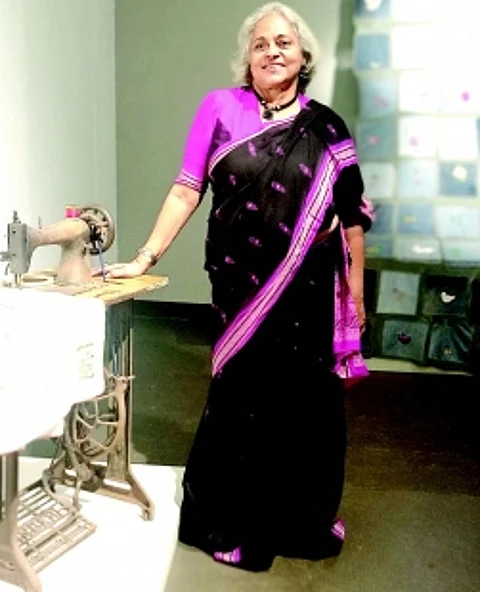

Very good news that Carmona’s Talking Quilt – the remarkable multimedia exhibition centered on narrative embroidered artworks by Dr Savia Viegas – has been extended until May 12, at the increasingly invaluable Museum of Goa (MOG) in the Pilerne Industrial Estate. This is the opportunity for those who have not yet ventured there to view this rich and revealing collection, and new landmark for Goan art in the 21st century. Over the past few years, we have seen a broad range of ambitious exhibitions in India’s smallest state via big-budget events like the Serendipity Arts Festival, but this intriguing set of stitched village scenarios that was conceived and created in solitude in a quiet corner of Salcete is amongst the best. It is to be hoped as many people as possible take the time to visit and enjoy the display before it is packed up next month.
Viegas is a distinguished scholar, with a doctorate in Ancient Indian Art from the University of Mumbai, who has been awarded senior fellowships from the Ministry of Culture of the Government of India (to study Goan family photographs) and the Fulbright Program of the USA Government (where she was associated with the Smithsonian Institution). Since returning to live in her ancestral home in beautiful, bucolic (but severely threatened by rapacious real estate “development”) Carmona in 2005, she has managed the pre-primary school Saxtti Kids, and branched gracefully into myriad dimensions of storytelling via writing and books – we are both members of the Goa Writers group – as well as painting, and now embroidery. Carmona’s Talking Quilt shines brightly in summation of those experiments and endeavours, by threading deep with lasting power into family and community cultural history.
“My mother Berta Elisa Viegas had to discontinue schooling when family funds ran out due to her father’s early paralysis,” explains Viegas, “but an independent personality streak led her to seek options to provide a source of income. Her sewing teacher was Dona Leonora, a renowned seamstress in Margao who trained girls in this very useful domestic craft. Mai tried hand-stitching clothes before she could afford a second-hand machine, then purchased a Singer.”
By the time Savia was born in 1957, her mother had already set up a sewing and embroidery school which kept her very busy: “It was a fun school as far as I remember, the girls sewed, laughed, shared food and anecdotes. It certainly was a better place to be than my school which had rules and punishments. When I grew up, I wanted to be an embroideress like my mother, but that was not to be. She taught the trousseau-making girls, the marriage-proposal awaiting ones as well as my cousins, but not me! But not me! This created a major rift between us when I was growing up.”
Fast forward to 2015, when the elder Ms. Viegas passed away, and her daughter had to sort through her cupboards: “out popped this huge and heavy denim quilt made from outgrown jeans. When I opened it out, and reworked it with crochet, it was a pilgrim’s journey to an old shrine. I realised, in barring my early entry into embroidery, Mai had actually given me wings to soar to a different world and grow tall. Very little of what I do today was taught by Mai, but growing up at that time, with craft ideas all around, it was not difficult picking up little instructions in school, from friends and neighbours. I loved sewing, lace-making and embroidery, but this is the first time these skills have been recruited and displayed in a professional artspace by me. It was all very accidental, but eye opening. The artspace is hierarchical, and does not provide easy entry to self-taught practitioners. Embroidery and lace - hitherto perceived as women’s skills - are now breaking the glass ceiling, and seeking parity in biennales across the world. In employing a traditional skill, and picking cues from sashiko, boro and katha stitches, I was able to harness some of the oral narratives of my childhood.”
No spoiler alerts here, and the Carmona’s Talking Quilt exhibition at MOG does consist of several additional displays, but its core and centrepiece is the lineup of vivid, densely embroidered one-panel “short stories” with accompanying texts in the register of magic realism. Here are secrets of the aldeia etched in acid, the obverse of Mario Miranda’s innocent Loutolim. They’re highly compelling, with a strong connection to the multimedia artistic lineage of Harlem-born Faith Ringgold – she passed away at 93 last month – whose best work was similarly created in dialogue with her expert seamstress mother. Just like Viegas, this great self-taught master sought inspiration and influence from around the world, incorporating and adapting Tibetan and Nepali aesthetics to create quilted fabric narratives where “people could still read my stories.”
Viegas told me “a bus full of Carmonekars visited MOG wanting to check out the representation of their village, and totally loved it. I had Noel Sequeira commenting that he thought he had lived in a very ordinary village till my writings and paintings opened up its magic. There you are! The magic was already there, you just needed a catalyst to ignite it for all to see, and I think I have done that. I love telling stories, whether in fiction, in art, in embroidery or in a class room. I love the power that colour and words can have on human imagination, and the power to wield both. An adrenalin rush spirals in my body when listeners begin to emote to a story that I have told, or repeat it on another occasion. I love to unravel and demystify my art practice so that people can take home the nuggets of my work. As an art historian, the voyage of looking at Indic and European art privileges you, as well as trains the eye. It baptises you to be an artist if you are willing.”